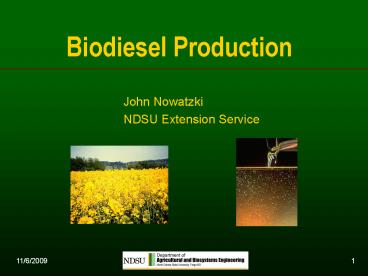Biodiesel Production - PowerPoint PPT Presentation
1 / 15
Title:
Biodiesel Production
Description:
The most common process used to convert these oils to biodiesel is called ... Glycerin can be distilled to 99% purity and used in cosmetics and pharmaceuticals ... – PowerPoint PPT presentation
Number of Views:206
Avg rating:3.0/5.0
Title: Biodiesel Production
1
Biodiesel Production
- John Nowatzki
- NDSU Extension Service
2
Introduction
- What is Biodiesel?
- What is Transesterification?
- Biodiesel Production Process
- Biodiesel Engine Fuel Characteristics
- Biodiesel Strengths Weaknesses
3
What is Biodiesel?
- Biodiesel is an engine fuel made from vegetable
oils and animal fats - The most common process used to convert these
oils to biodiesel is called transesterification
4
What is Transesterification?
- The reaction of an alcohol with the oil to form
esters (biodiesel) and glycerol - The reaction requires
- Catalyst (potassium or sodium hydroxide)
- Agitation
- An excess amount of alcohol
- The alcohol actually reacts with the fatty acids
in the oil to form the mono-alkyl ester
(biodiesel) and crude glycerol
Transesterification
5
Results of Transesterification?
- The transesterification reaction results in the
separation of the ester (biodiesel) and glycerol
layers - The heavier glycerol settles to the bottom and is
removed - 100 gallons of vegetable oil yields
- 99 gallons of Biodiesel
- 22 gallons Glycerol
6
Biodiesel Production Process
7
Biodiesel Production Process
- Mixing of methanol, catalyst and oil
- Sodium or potassium hydroxide is dissolved in the
alcohol using agitation - The alcohol/catalyst is added to the oil
- Temperature 100 -160 F for 1 to 8 hours
- Excess alcohol is used to ensure total conversion
of oil to esters
Methanol
8
Biodiesel Production Process
- Separation
- Glycerin is more dense than biodiesel
- Gravity separation makes it possible to draw
glycerin off the bottom of the settling vessel
9
Biodiesel Production Process
- Methanol Removal
- Excess methanol is removed from both the glycerin
and biodiesel - Evaporation or distillation
- The recovered methanol is re-used
10
Biodiesel Production Process
- Glycerin Neutralization
- The glycerin contains unused catalyst and soaps
that are neutralized with an acid to form crude
glycerin. - Salt formed during processing can be used as
fertilizer. - Water and alcohol are removed to produce 80-88
pure crude glycerin - Glycerin can be distilled to 99 purity and used
in cosmetics and pharmaceuticals
11
Biodiesel Production Process
- Biodiesel Wash
- The biodiesel is sometimes purified by washing
with warm water to remove residual catalyst - Resulting product is a clear amber-yellow liquid
with a viscosity similar to petrodiesel.
12
Biodiesel Production Process
- Biodiesel Quality
- Important quality control aspects of biodiesel
production are - Complete Reaction
- Removal of Glycerin
- Removal of Catalyst
- Removal of Methanol
- Absence of Free Fatty Acids
13
Biodiesel Fuel Characteristics
14
Biodiesel Strengths Weaknesses
- Potential Strengths
- Requires little or no engine modifications
- Easily blended with other diesel fuels
- Better lubricant than petrodiesel
- Production yields valuable byproducts
- Lower sulfate and hydrocarbon emissions than
petrodiesel - Current US Government subsidy
- Potential Weaknesses
- Gel problems at cold temperatures
- Fewer BTUs per gallon than petrodiesel
- Fuel filter plugging at lower temperatures
- Deterioration of seals in pre-1993 engines
- when using B10 or higher
15
More Information
- http//www.ag.ndsu.nodak.edu/abeng
- John Nowatzki, NDSU Extension State Specialist
- Telephone 701-231-8213
- Email John.Nowatzki_at_ndsu.edu































